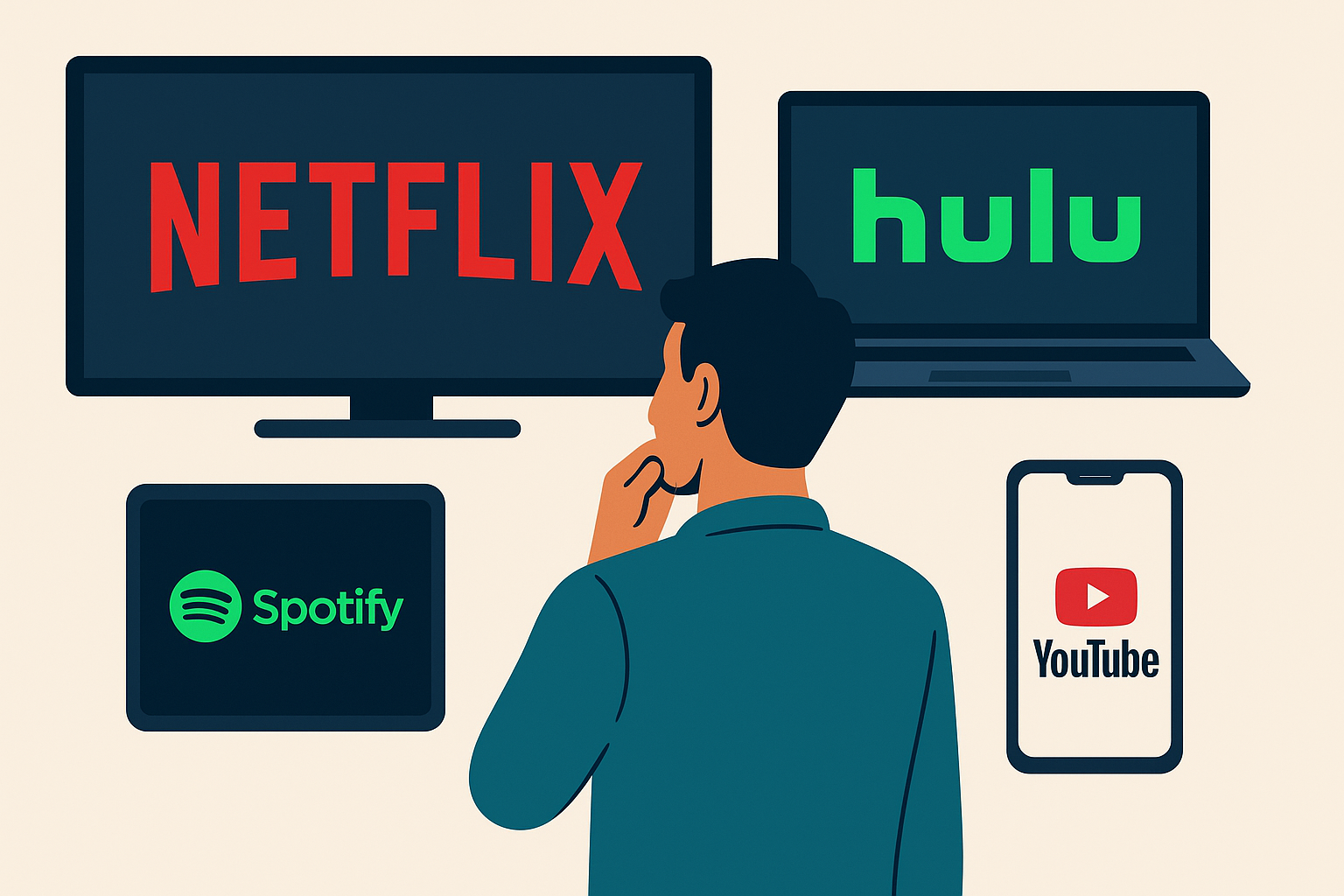How Much Are You Really Paying Per Minute for Your Streaming Services

Be honest — do you know exactly how many streaming subscriptions you’re paying for right now?
Netflix, Hulu, Disney+, Max, Amazon Prime Video, Spotify, Apple Music, maybe even YouTube Premium… the list goes on.
We sign up because it’s “just $9.99” or “only $14.99,” and then before you know it, half your credit card statement is streaming platforms and cloud storage.
But here’s a question hardly anyone asks:
👉 How much are you actually paying per minute of streaming time?
That number says a lot about whether your subscriptions are worth it — or if you’re just paying for comfort and habit.
Let’s break it down using current U.S. prices and average usage stats.
Streaming Is Still Booming — But So Are the Prices
Over the last few years, nearly every major streaming platform has raised prices. The “cheap” streaming era is long gone.
Here’s what you’ll typically pay per month for the most popular U.S. streaming services:
Service | Ad-Supported Plan | Ad-Free Plan | Notes |
|---|---|---|---|
Netflix | $6.99 | $15.49 (Standard), $22.99 (Premium) | Password sharing crackdown continues |
Disney+ | $7.99 | $13.99 | Ad-free bundle w/ Hulu: $19.99 |
Hulu | $7.99 | $17.99 | Standalone or bundled |
Max (formerly HBO Max) | $9.99 | $16.99 | Ad-free tiers include offline downloads |
Amazon Prime Video | $8.99 | $11.98 (ad-free upgrade added recently) | Included in Prime or standalone |
Apple TV+ | N/A | $12.99 | Still ad-free for now |
Spotify | N/A | $11.99 | Music only, but huge time sink |
YouTube Premium | N/A | $13.99 | Ad-free + background play |
In 2020, you could get Netflix for $8.99. Now, the same ad-free plan is nearly double that.
So it’s fair to ask: is the entertainment we’re getting keeping up with what we’re paying?
Average Streaming Time Today
Before calculating cost per minute, we need to know how much people are watching.
According to recent viewing reports and surveys, here’s how much U.S. adults watch or listen on average:
Netflix: ~2 hours 15 minutes per day
YouTube: ~1 hour 10 minutes per day
Disney+: ~55 minutes per day
Spotify (audio): ~1 hour 45 minutes per day
Some people stream more, others less — but these averages give us a solid baseline.
Now, let’s crunch the numbers.
The Math: How Much You’re Paying Per Minute
1. Netflix
Let’s use the Standard ad-free plan ($15.49/month).
Assume you watch about 2.25 hours/day = 135 minutes/day.
That’s 4,050 minutes/month (30 days).
$15.49 ÷ 4,050 = $0.0038 per minute
👉 That’s less than half a penny per minute.
Pretty good deal if you watch regularly.
But if you only stream, say, 3–4 hours a week (~720 minutes/month), the math changes:
$15.49 ÷ 720 = $0.0215 per minute
That’s five times higher.
Moral: the less you watch, the more expensive every minute becomes.
2. Spotify
Spotify Premium is $11.99/month in the U.S.
Let’s assume average usage of 1 hour 45 minutes/day = 105 minutes/day → 3,150 minutes/month.
$11.99 ÷ 3,150 = $0.0038 per minute
So, roughly the same as Netflix for heavy users.
But again, if you only listen during workouts (say 30 minutes/day), you’d hit 900 minutes/month → $0.013 per minute — 3× more expensive per minute.
3. Disney+
Ad-free is $13.99/month, and the average Disney+ user watches about 55 minutes/day (1,650 minutes/month).
$13.99 ÷ 1,650 = $0.0084 per minute
That’s about twice as expensive per minute as Netflix — mostly because people use it less frequently.
Disney+ has become more of a “family night or kids’ content” platform, not a daily watch like Netflix or YouTube.
4. YouTube Premium
YouTube Premium runs $13.99/month, removing ads and allowing background playback.
If you use it about 1 hour 10 minutes/day (2,100 minutes/month):
$13.99 ÷ 2,100 = $0.0066 per minute.
Not bad — but the value depends on whether you really hate ads or multitask with YouTube open in the background.
5. Amazon Prime Video
Prime Video is interesting because many people get it “for free” as part of their Prime membership — but Amazon recently started showing ads unless you pay an extra $2.99/month for ad-free viewing.
Let’s assume you’re paying the standalone $11.98/month ad-free version and watching about 1 hour/day (1,800 minutes/month).
$11.98 ÷ 1,800 = $0.0066 per minute
Similar to YouTube Premium — decent, but not dirt cheap.
Quick Comparison
Platform | Monthly Cost (Ad-Free) | Avg. Minutes Watched/Month | Cost Per Minute | Comments |
|---|---|---|---|---|
Netflix | $15.49 | 4,050 | $0.0038 | Heavy users get great value |
Spotify | $11.99 | 3,150 | $0.0038 | Similar cost/min as Netflix |
Disney+ | $13.99 | 1,650 | $0.0084 | Costs more per min due to lower use |
YouTube Premium | $13.99 | 2,100 | $0.0066 | Solid if you’re always on YouTube |
Prime Video | $11.98 | 1,800 | $0.0066 | Competitive, but content varies |
Apple TV+ | $12.99 | ~1,000 | $0.0130 | Great originals, low volume |
Max (HBO) | $16.99 | ~1,500 | $0.0113 | Pricey but premium content |
Average: About $0.007 per minute — meaning every 100 minutes of streaming costs you roughly 70 cents.
So… Are We Getting What We Pay For?
In most cases, yes — if you actually use it.
Streaming services are designed to feel cheap compared to cable or movie theaters.
If you’re watching multiple hours per day, you’re paying just a few cents an hour.
But if you’re too busy to watch often, that same subscription can quietly become a bad deal.
Let’s say you barely touch your Netflix account for a month — maybe 3 episodes total (~150 minutes).
$15.49 ÷ 150 = $0.10 per minute.
That’s $6 an hour.
You could literally rent a movie cheaper.
When “Subscription Fatigue” Hits
The average U.S. household now pays for around four paid video streaming services and two music or audiobook subscriptions.
The problem? Nearly half of subscribers say they’ve canceled at least one service in the past year due to price hikes or “not using it enough.”
Streaming used to save money vs. cable. Now, when you stack them all up, it’s common to spend $80–$120/month — and that’s before internet costs.
If you’re feeling the pinch, you’re not alone.
The “Hidden” Streaming Cost: Your Internet Plan
Let’s not forget the bandwidth side.
Streaming video eats data — and internet plans aren’t always unlimited.
Netflix HD: ~3 GB/hour
4K UHD: up to 7 GB/hour
YouTube 1080p: ~1.5 GB/hour
Spotify music: ~70 MB/hour
If your internet plan has a 1 TB monthly data cap, streaming 4K video 4 hours a day can use nearly all of it. Go over, and you’ll face overage fees or throttled speeds.
So the “real” cost of streaming isn’t just your subscription — it’s also your ISP plan keeping up.
Let’s Imagine: If Facebook or TikTok Charged You
It’s not as far-fetched as it sounds.
X (formerly Twitter) already offers paid tiers. Instagram and TikTok have tested ad-free options.
Let’s say Facebook or TikTok charged $0.005 per minute (about half a penny, similar to Netflix’s cost per minute for heavy users).
If you spend:
30 minutes/day → 900 minutes/month → $4.50/month
1 hour/day → 1,800 minutes/month → $9/month
2 hours/day → 3,600 minutes/month → $18/month
That’s roughly in line with streaming platforms. Which tells us: if social media ever went fully subscription-based, it wouldn’t be cheap — because we spend way more time scrolling than streaming.
How to Get the Best Value from Your Subscriptions
Here are a few smart ways to stretch your dollars:
Track Your Real Usage – Every few months, check your app history. If you haven’t opened a service in 3 weeks — you’re paying for air. Cancel it, or pause it until you need it again.
Bundle Strategically – Disney+, Hulu, and ESPN+ bundle for $19.99/month. That’s cheaper than subscribing to them separately.
Rotate Services – Don’t subscribe to everything at once. Watch what you want on Netflix, then pause it and move to Max for a month. Most services let you cancel anytime.
Try Ad-Supported Plans – The new “with ads” tiers are much cheaper and often still HD quality. If you don’t mind a few commercial breaks, you can cut monthly costs in half.
Use Family Plans Wisely – Spotify, YouTube, and Apple Music all have family tiers that let multiple users share an account legally. Split costs and save.
Keep an Eye on Free Alternatives – Free services like Pluto TV, Tubi, and The Roku Channel have grown a lot. They’re ad-supported but completely free — perfect for casual watching.
The Bottom Line
Streaming is still one of the best entertainment values around — if you actually use it.
At roughly half a penny per minute, Netflix or Spotify still deliver incredible bang for your buck compared to movie tickets or cable TV.
But as subscription prices climb and competition explodes, it’s worth taking stock of your digital diet.
You don’t need 10 subscriptions to stay entertained — you just need the right ones for your lifestyle.
The next time you see that $14.99 charge on your card, ask yourself:
“Did I actually watch enough this month to make it worth it?”
If not, maybe it’s time to hit “Cancel” — or at least take a streaming detox.
Related Posts

Tue, Dec 9, 2025 2:32 AM
Internet BundlesIs Your ISP Throttling Your Internet? Here’s How to Tell
This explains the signs, testing methods, and solutions to prevent speed slowdowns and maintain consistent performance.

Mon, Dec 8, 2025 5:48 AM
Internet BundlesSmarter Ways to Get Internet Without a Phone Line or Cable TV
Learn the best ways to get internet without cable TV or a phone line. Explore DSL, fiber, satellite, and fixed wireless options with a simple, natural guide for today’s cord-cutting households.

Mon, Dec 8, 2025 2:24 AM
Technology Broadband InstallationHow to Check and Fix Ethernet Port Problems
Learn how to diagnose and fix Ethernet port issues with this complete troubleshooting guide. Covers physical checks, cables, software settings, and when to contact a technician.

Fri, Dec 5, 2025 12:20 PM
TechnologyWhy You Need a VPN Today (and How It Protects You Online)
Learn how VPNs protect your data, block tracking, and secure your connection across every device.

Thu, Dec 4, 2025 3:30 AM
Internet BundlesBest Fiber Internet Providers in the US : Fast, Reliable, and Worth It
Discover the top fiber internet providers in the US, their speeds, pricing, and customer satisfaction ratings. Find the best plan for fast, reliable, and uninterrupted internet.